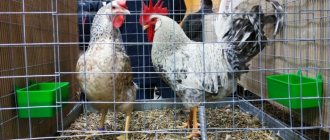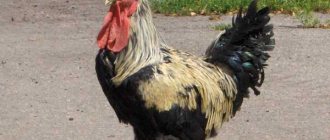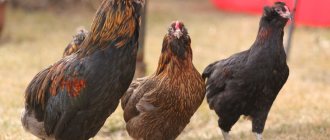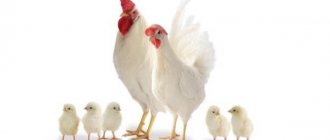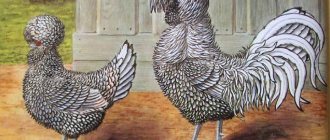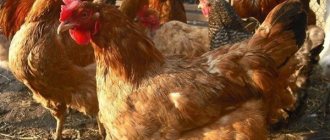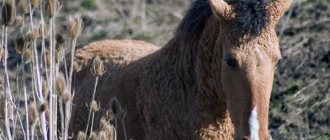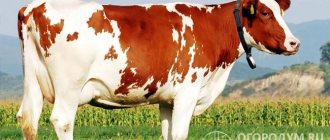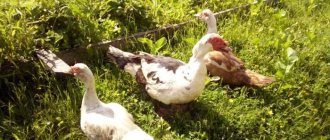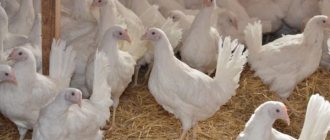Leghorn is a fairly young breed of chicken that was bred in Italy in the 19th century. The bird very quickly gained popularity due to its rapid growth and excellent egg production. After the bird spread throughout Europe, mass breeding work began, which made it possible to develop 20 more subspecies.
In this article we will provide a detailed description, show photos of chickens, and also provide reviews from those farmers who were lucky enough to get to know this layer from their own experience.
Description
Thanks to breeding work, scientists were able to develop a diverse number of colors for this breed. It is worth noting that even today breeding work is carried out on this bird to improve its qualities.
But, despite everything, there is a classic color that is already considered an unspoken standard. This is a white type of feather. This is the color that generally characterizes Leghorn chickens.
Externally, it is quite easy to distinguish them from the same Jersey giants or Cochins. They have a small build and a blade-shaped body. Perhaps only this breed has this type of body.
The skin of a chicken has a yellow tint; in rare cases, there are individuals with a flesh color.
By the ridge it is easy to determine where the male is and where the female is. Typically, females have a large drooping crest, while males have an erect crest.
If you look at the bird's head, you will notice that it has a rather short beak. One of the shortest among all breeds. The edge of the beak is slightly curved.
Their back is straight, their chest protrudes.
Juveniles have yellow legs. With age, it fades and eventually the paws turn white.
The tail is bushy. This applies to both female and male representatives.
What do chickens look like?
Leghorns are characterized by a small constitution, which is distinguished by a wedge-shaped body that has a proportional build. The chest is round in shape and protrudes slightly forward. The back has a concavity in the middle.
The head is small in size with a scarlet leaf-shaped crest. Roosters have an erect comb; in laying hens it hangs to one side. Adult representatives are characterized by a change in eye color; initially they are orange, and then become light yellow.
The earlobes are snow-white, the beard with a smooth curve is scarlet. The elongated neck has a curve. The limbs also change color over time; in young animals they are bright yellow, and then become white and blue.
You can distinguish hens from roosters by their tails. For the former, it goes down to the bottom, and for the latter, on the contrary, it rises. Leghorns are usually divided into species based on color. Most often you can find:
- white leghorns;
- partridge;
- fawn.
Productivity
The breed has gained particular popularity due to the number of eggs it produces. There is perhaps no breed that can compare with Leghorns. In a year, one bird can easily produce up to 300 eggs. Moreover, so many eggs can be obtained in the first year of a bird’s life.
Another advantage of this species is its rapid maturation. Chickens begin laying eggs at 5 months of age. At this time the rooster also matures.
In addition to the fact that they produce a lot of eggs, they are also impressive in size. The weight of one egg is often 70 grams. But, in general, the average weight is 60 grams. But even 60 is more than the usual 45-50 grams.
The shell is white and quite durable.
As for meat qualities, they are at a low level. And there are two main reasons for this:
- First of all, chickens are quite easy. The weight of an adult does not exceed 2 kg. Roosters are a little heavier, but only by 400-500 grams. However, a bird reaches such a weight with good fattening; on average, the weight of one laying hen does not reach 2 kg.
- Secondly, Leghorn meat is of low quality. It is hard to chew and has no juiciness.
Story
Leghorn chickens were first bred by Italian breeders in the nineteenth century. This is a fairly young breed.
The main difference between poultry and other species is its rapid growth rate, high productivity rates, and the onset of early maturity.
After Italy, chickens became very popular in large cities in America and Europe. Work with the view continued in an intensified manner. Breeders have managed to breed different lines of birds, which have about 20 plumage colors.
The line closest to us turned out to be crosses of Belarusian origin. Back in Soviet times, individuals raised in America, Holland, Germany and Japan were brought to the territory of our country. Thanks to crossing, which began to be practiced back in the 60s of the 19th century, individuals were born with excellent characteristics many times superior to their parents. The greatest flowering of the species was recorded in the twentieth century. At this time, a large number of meat and egg chickens were bred, which were actively used in agricultural production.
Advantages
In addition to the fact that the breed lays a lot of eggs, it has many other advantages. For example, one of them is low maintenance. Someone says that chickens often die, but this is the case if there is no care at all. If the minimum rules are followed, Leghorns will not cause any trouble.
In addition, this bird has a rather calm and friendly character. Chickens quickly get used to their owner and are ready to run after him all over the countryside.
Also worth noting is their adaptability. They get used to almost any conditions. The breed feels quite well in the heat, and no less well in severe frosts. The winter season, during which almost all breeds stop laying eggs, does not affect Leghorns in any way. They rushed in the fall, and continue to do so when there is snow on the street.
Using Leghorns in breeding crosses
This breed is very popular as a basis for breeding high productivity crosses. The most popular one available today is Rhodonite. The variety accounts for more than 40% of the entire egg-producing population in the country. The cross appeared as a result of six years of work with the genetic material of Leghorn and brown Lohmann. The cross has the highest productivity - 296 eggs.
Rhodonite is not the only cross from Leghorn, but it is the most successful. The list of others is quite impressive, but it is united by one common essence: the Leghorn breed is an excellent basis for the creation of more and more new varieties with remarkable productivity qualities, health indicators and adaptive data.
Negative sides
Despite the fact that chicken productivity is one of the highest, it decreases very quickly. Already in the second year of life, a rapid decline is observed. So, 2-year-old chickens can already produce 150 eggs per year. These are critical indicators for this breed.
Because of this shortcoming, experienced farmers try to replace chickens every 1.5-2 years. In fact, this is a pretty good solution. You can get meat every year and maintain productivity at a high level.
But unfortunately, the issue of updating is not so simple when it comes to Leghorns. This breed completely lacks the instinct to procreate. They do not hatch eggs, so to update old chickens you will have to buy them. Alternatively, you can also give Leghorn eggs to other breeds.
It is worth noting that, nevertheless, some individuals of this breed sometimes begin to hatch eggs. But in most cases this does not end well.
Reviews
Leghorn chickens have received the most positive reviews from poultry farmers. The breed is distinguished by high levels of egg productivity, unpretentiousness and adaptability to living conditions.
Birds are actively used on industrial and private farms as genetic material for breeding new highly productive crosses.
Among the disadvantages are the lack of brooding instinct and the high price of high-quality young animals. It should be remembered that in the second year egg production decreases, so the population of laying hens should be updated in a timely manner.
Varieties
A large number of crosses were bred at the Leghorn base.
White Leghorn
Leghorn, familiar to many. A feature of this species is its resistance to various climatic conditions. Chickens thrive in warm and temperate climates. They stop laying eggs when the temperature drops below 0 degrees Celsius. This is a fairly unpretentious breed both in terms of care and feeding. Today, white Leghorn is one of the most popular breeds in poultry farms. Chickens thrive in cages, which is another plus for industrial production.
Dwarf Leghorn
These are the so-called “mini-chickens”. They have fairly miniature dimensions. The average weight of an adult representative of the Dwarf Leghorn reaches 1.4-1.6 kg. It is worth noting that dwarfism of the species is easily inherited.
Despite its small size, the species has excellent egg production. He is as unpretentious as the representatives of the white Leghorn.
The plumage color of dwarf individuals is most often white. This is a very economical breed, as it requires almost 2 times less feed than representatives of larger breeds.
Striped Pied
This subspecies was bred by domestic breeders back in the days of the Union, in the 80s. Striped-motley was created through the most severe selection. Thanks to the work done, the subspecies received:
- High egg production rates. The subspecies produces about 220 eggs per year. The eggs are cream or white.
- Ripens very early.
- Decorative appearance.
The body weight of the striped motley is from 1.7 to 2.5 kg. The fertilization of eggs is almost 100%, the survival rate of both young and adult chickens is also at a high level.
Dalmatian spotted
One of the very popular Leghorn subspecies. Dalmatians have white and black spotted plumage. This subspecies was bred at the beginning of the 20th century, and the Dalmatian was initially considered an anomalous chicken.
Partridge-cuckoo
Representatives of this subspecies can be easily distinguished by gender from the first days of birth. Cockerels are lighter in color than hens. This subspecies does not require any specific housing conditions. In terms of nutrition, they are also not picky. The character is calm and friendly. The productivity of the partridge-cuckoo is high, the eggs are medium in size, with a white shell color. The average weight of a bird reaches 3.5 kg.
Golden
One of the most decorative and beautiful varieties of this breed. The egg production rates of the bird, despite its compact size (from 1.9 to 2.1 kg), are very high and reach 260 eggs per year. The eggs are quite large, reaching 60 g.
Conditions and care
Leghorns can be kept both in cages and spacious enclosures. These birds are shy. Roosters can be aggressive. The chicken coop must be insulated. It is advisable to install a plank floor. Chopped hay or sawdust is used as bedding. Feeders, drinking bowls, nests and perches should be located indoors. For perching, poles are better suited, the diameter of which should be no more than 4 cm.
It is advisable to install a fence for walking next to the poultry house. To make it a small area, you should fence it off with a net. The height of the fence must be at least 1.5 m. Inside it there are feeders, drinking bowls and a container with ash so that the birds can clean their feathers.
Chickens must have a warm chicken coop and an area for walking.
Industrial breeding
On an industrial scale, Leghorns are often raised in cages. Cells are often arranged in close rows. White chickens are often bred on an industrial scale to produce eggs. Birds are often given antibiotics and hormones to prevent diseases from developing due to being kept in close quarters. At the same time, growing in cells leads to rapid depletion. Chickens of this breed are used on poultry farms for no more than a year to produce eggs, and then sent for slaughter.
Chickens in poultry farms are kept in cages, which leads to their rapid depletion.
Farming
Egg products obtained on farms are of higher quality. Here chickens are raised in large hangars. Laying hens have greater freedom, so unnecessary use of hormones and antibiotics is not required. Often, farms also have pens designed for walking poultry in the fresh air. This increases the period of use of chickens for eggs.
Keeping chickens on a farm yard.
Home content
All varieties of Leghorns are suitable for home keeping. There should be up to 15 laying hens per 1 rooster. It is imperative to provide additional lighting in the chicken coop to prolong daylight hours for chickens in the winter. This will prevent a drop in egg production. When kept at home, birds receive more balanced feed; mineral supplements are important for this breed. They need to be systematically introduced into the diet.
Feeding
Leghorns are unpretentious chickens in terms of nutrition. Their diet, in general, is no different from the diet of other breeds. The main thing for Leghorns is a balanced diet. The bird must receive the amount of vitamins and minerals it needs.
Particular attention is paid to feeding chickens:
- From the first to the third day, the young animals are fed boiled grated eggs.
- On the 4th day, greens are added to the diet: dandelion leaves, nettles, etc.
- On the 5th day, feed chalk is introduced into the diet to enrich the chicken’s body with calcium.
- Feeding young animals consists of at least 6 meals per day.
- From the 3rd week, you can transfer the chickens to the diet of adult chickens, only the grains are crushed into a smaller fraction.
As for adults, their diet consists of:
- Bone meal.
- Grain feed (50% of the total diet).
- Vegetables.
- Herbs.
- Mela.
- Table salt.
- Crushed shell rock.
In the morning and evening, the birds are given grain feed. For lunch, it is recommended to feed them mash with added salt and vegetables.
Since this breed is a laying hen, it needs large amounts of protein and calcium. With their shortage, there is both a decrease in chicken productivity and the laying of smaller eggs.
Nutrition of adult birds
Leghorns are unpretentious chickens and eat 25-30% less than others.
The diet includes various grains, bran, seasonal vegetables and fruits. In summer they give chopped greens. In winter - sprouted wheat grains.
Leghorns benefit from food of animal origin: fish meal, a little curdled milk or cottage cheese.
A sufficient amount of calcium, due to which a hatching egg with a strong shell is formed, ensures the introduction of chalk, limestone or special vitamin supplements into the diet.
Gravel, crushed shell rock and other small pebbles are used to grind large fractions of food into the crop.
It is important that chickens have 24/7 access to clean, fresh water. But the food, if the chickens haven’t eaten it within two hours, is removed, subsequently adjusting the portion size.
Diseases
This breed has a strange disease - noise hysteria. This disease develops with increased noise. The disease leads to the fact that chickens begin to behave inappropriately, show aggression towards each other, cackle loudly, flap their wings, and beat against walls in hysteria. This naturally leads to damage, loss of plumage, and decreased productivity. Attacks of noise hysteria can occur several times a day. Many experts advise chickens to play relaxing music to accustom them to sounds and protect them from the onset of disease.
As for other diseases, everything is standard here. Leghorns are not particularly different from other breeds, and are also susceptible to a number of diseases that other chickens may encounter.
Chickens
The only problem in breeding winged Italians is the lack of maternal instinct in the kites. It is for this reason that many farmers prefer not to engage in breeding, but each time to purchase a new family of chickens, the raising of which does not require special training and knowledge.
Babies are born in fluffy downy coats, which are very quickly replaced, overgrown with adult feathers. Leghorn chickens grow very quickly if they are provided with high-quality and balanced feed.
They rarely get sick and survive in 95% of cases. Good health is observed not only in young animals, but also in adults.
By the time egg laying begins, chickens can be switched to an “adult” diet. There are no special recommendations regarding the composition of the diet of young animals. They can be kept on food that is traditional for all birds. Here are a couple of tips regarding proper nutrition for chicks.
- Mash made from eggs, cereals and herbs must be made one time at a time to avoid spoiling. This product will be the basis of the children's table for only 2 weeks, from the first meal.
- Cottage cheese, yeast, fish oil are useful additives that saturate growing organisms with essential nutrients and are easily digestible. These components can also be added daily.
- Vitamin supplements in liquid form should be given at least 2 times a week. In addition, calcium and other minerals are in the form of bone meal or ground chalk, shells.
